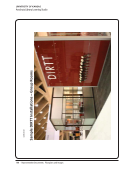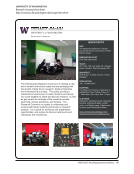SPEC Kit 327: Reconfiguring Service Delivery · 19
from reconfiguration. Benefits appeared to accrue both
for the user and for the library and its personnel.
Visibility of service, service points or particular
collections that had been relocated was the user ben-
efit most frequently mentioned. One-stop shopping,
with several services combined at one service desk,
was listed as a major benefit by many of the respon-
dents. They pointed out that both of these benefits
have led to less confusion for their library users.
Improved study spaces, collaborative and/or well-
equipped student workspaces resulted at several of
the libraries responding to the survey. Reference ser-
vice appears to have become more personalized and
individualized for users. Other libraries indicated
they were able to expand hours of operation for users
through the reconfiguration of their services. One
library stated that the library was now “a draw for
students who had never been there before.” In sum
many responses to this question indicate that the re-
configurations have created spaces and services that
are more welcoming and less intimidating for users,
that these libraries are striving to provide services
their users want and need.
Many benefits from the library operation view-
point were listed as well. Cost savings was evident
in the responses that stated student/hourly budgets
were reduced to save funds. It appears that in many
cases the reconfigurations have resulted in more ef-
fective and efficient use of personnel. Librarians and
staff have been cross-trained or retrained and the
result is more flexibility for the library and a better
understanding by library personnel of each other’s
knowledge and capabilities, helping the libraries to
put those skills to use for best advantage. The addi-
tional training also has resulted in more consistency
in the answers users get for the questions they ask.
One respondent commented that librarians working
at a single service point desk were able to serve as
mentors and model good service behaviors for staff.
Several respondents pointed out that a librarian
advantage was spending less time at a reference desk.
The operating efficiencies provided by service recon-
figurations allow personnel time to be redirected to
other activities such as classroom teaching, outreach
to departments within the home institution, advanced
reference service through appointments and question
referral, librarians becoming “embedded” in subject
discipline offices to provide services on-site, creat-
ing online learning materials and credit courses,
pursuing more assessment activities, and establish-
ing new services such as an institutional repository.
Improvement of “back room operations” was noted
by several respondents, as was the ability to provide
better workspace for library personnel.
Unlike benefits that were achieved for both the
libraries and their constituents, the bulk of challenges
seemed to accrue to the library side of the equation.
For constituents the challenges were adjusting to
physical rearrangements or being philosophically
opposed to the changes (e.g., branch library closures).
Respondents reported that library personnel also had
some difficulties adjusting to the reconfigurations.
Several mentioned that getting staff buy-in or over-
coming resistance to change has been a difficulty.
Helping staff adapt to the changes and maintaining
staff morale were noted as areas that needed a great
deal of attention. Training and retraining were noted
as being both labor-intensive and disruptive to pro-
viding services. Some respondents acknowledged that
the physical arrangement of the service points turned
out to be not as beneficial as anticipated. In the case
of branch library closures, the integration of library
collections was noted as time consuming and compli-
cated, requiring physical relocation of materials and
adjustments to bibliographic and location records in
the libraries’ catalog systems.
In balance, the benefits noted far out-numbered
the challenges. It is left to libraries considering re-
configurations to consider the impact of both when
planning to make significant changes such as those
described here.
Anticipated Additions, Closures, Consolidations
and Other Reconfigurations
In the final segment of the survey respondents were
asked if they anticipated reconfiguring a branch li-
brary or staffed service point in the next three years.
Forty-nine (83%) replied yes. Forty-seven of these
anticipate a total of 70 service point changes and 40
branch library changes. As with completed service
point changes, they expect more consolidations (33)
and reconfigurations (21) than additions or closures (8
from reconfiguration. Benefits appeared to accrue both
for the user and for the library and its personnel.
Visibility of service, service points or particular
collections that had been relocated was the user ben-
efit most frequently mentioned. One-stop shopping,
with several services combined at one service desk,
was listed as a major benefit by many of the respon-
dents. They pointed out that both of these benefits
have led to less confusion for their library users.
Improved study spaces, collaborative and/or well-
equipped student workspaces resulted at several of
the libraries responding to the survey. Reference ser-
vice appears to have become more personalized and
individualized for users. Other libraries indicated
they were able to expand hours of operation for users
through the reconfiguration of their services. One
library stated that the library was now “a draw for
students who had never been there before.” In sum
many responses to this question indicate that the re-
configurations have created spaces and services that
are more welcoming and less intimidating for users,
that these libraries are striving to provide services
their users want and need.
Many benefits from the library operation view-
point were listed as well. Cost savings was evident
in the responses that stated student/hourly budgets
were reduced to save funds. It appears that in many
cases the reconfigurations have resulted in more ef-
fective and efficient use of personnel. Librarians and
staff have been cross-trained or retrained and the
result is more flexibility for the library and a better
understanding by library personnel of each other’s
knowledge and capabilities, helping the libraries to
put those skills to use for best advantage. The addi-
tional training also has resulted in more consistency
in the answers users get for the questions they ask.
One respondent commented that librarians working
at a single service point desk were able to serve as
mentors and model good service behaviors for staff.
Several respondents pointed out that a librarian
advantage was spending less time at a reference desk.
The operating efficiencies provided by service recon-
figurations allow personnel time to be redirected to
other activities such as classroom teaching, outreach
to departments within the home institution, advanced
reference service through appointments and question
referral, librarians becoming “embedded” in subject
discipline offices to provide services on-site, creat-
ing online learning materials and credit courses,
pursuing more assessment activities, and establish-
ing new services such as an institutional repository.
Improvement of “back room operations” was noted
by several respondents, as was the ability to provide
better workspace for library personnel.
Unlike benefits that were achieved for both the
libraries and their constituents, the bulk of challenges
seemed to accrue to the library side of the equation.
For constituents the challenges were adjusting to
physical rearrangements or being philosophically
opposed to the changes (e.g., branch library closures).
Respondents reported that library personnel also had
some difficulties adjusting to the reconfigurations.
Several mentioned that getting staff buy-in or over-
coming resistance to change has been a difficulty.
Helping staff adapt to the changes and maintaining
staff morale were noted as areas that needed a great
deal of attention. Training and retraining were noted
as being both labor-intensive and disruptive to pro-
viding services. Some respondents acknowledged that
the physical arrangement of the service points turned
out to be not as beneficial as anticipated. In the case
of branch library closures, the integration of library
collections was noted as time consuming and compli-
cated, requiring physical relocation of materials and
adjustments to bibliographic and location records in
the libraries’ catalog systems.
In balance, the benefits noted far out-numbered
the challenges. It is left to libraries considering re-
configurations to consider the impact of both when
planning to make significant changes such as those
described here.
Anticipated Additions, Closures, Consolidations
and Other Reconfigurations
In the final segment of the survey respondents were
asked if they anticipated reconfiguring a branch li-
brary or staffed service point in the next three years.
Forty-nine (83%) replied yes. Forty-seven of these
anticipate a total of 70 service point changes and 40
branch library changes. As with completed service
point changes, they expect more consolidations (33)
and reconfigurations (21) than additions or closures (8






















































































































































































































